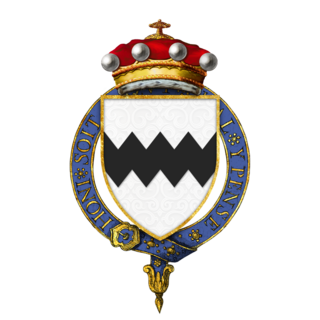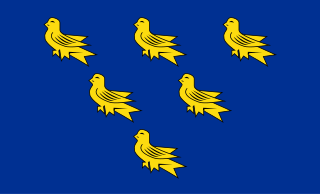
Eleanor Maltravers, or Mautravers, was an English noblewoman. The granddaughter and eventual heiress of the first Baron Maltravers, she married two barons in succession and passed her grandfather's title to her grandson.

Thomas Keyes or Keys was captain of Sandgate Castle, and serjeant porter to Queen Elizabeth I. Without the Queen's consent, he married Lady Mary Grey, who had a claim to the throne.

Thomas West, 8th Baron De La Warr and 5th Baron West, KB, KG was an English courtier and military commander during the reigns of Henry VII and Henry VIII.
Sir John Tyrrell lord of the manor of Heron in the parish of East Horndon, Essex, was Knight of the Shire for Essex, Speaker of the House of Commons, and Treasurer of the Royal Household.
John (II) de Mowbray, 3rd Baron Mowbray was the only son of John de Mowbray, 2nd Baron Mowbray, by his first wife, Aline de Brewes, daughter of William de Braose, 2nd Baron Braose. He was born Hovingham, Yorkshire.

Robert Radcliffe, 10th Baron Fitzwalter, 1st Earl of Sussex, KG, KB, PC, also spelled Radclyffe, Ratcliffe, Ratcliff, etc, was a prominent courtier and soldier during the reigns of Henry VII and Henry VIII who served as Chamberlain of the Exchequer and Lord Great Chamberlain.

Sir Gervase Clifton of Clifton, Nottinghamshire and London was a 15th-century English knight and landowner. He was beheaded after the Battle of Tewkesbury.
Thomas Poynings, 1st Baron Poynings was an English soldier and courtier.

Sir Richard Guildford, KG was an English courtier who held important positions at the court of Henry VII, including the office of Master of the Ordnance.

Sir John Fogge (c.1417–1490) was an English courtier, soldier and supporter of the Woodville family under Edward IV who became an opponent of Richard III.
Sir John Raynsford was an English politician.

Sir John Scott was the eldest son of Sir William Scott of Scot's Hall. He served in King Henry VIII's campaigns in France, and was active in local government in Kent and a Member of Parliament for New Romney. He was the grandfather of both Reginald Scott, author of The Discoverie of Witchcraft, a source for Shakespeare's Macbeth, and Thomas Keyes, who married Lady Mary Grey.
Sir Robert Oxenbridge (1508–1574) was an English Member of Parliament and Constable of the Tower.

Sir Adrian Poynings was a military commander and administrator. The youngest of the illegitimate children of Sir Edward Poynings, he played a prominent role in the defence of the English garrison at Le Havre in 1562–63.
Sir Robert Poynings, was the second son of Robert Poynings, 4th Baron Poynings (1382–1446). He joined the rebellion of Jack Cade in 1450, and was slain fighting on the Yorkist side at the Second Battle of St Albans in 1461.
Sir George Browne was the eldest surviving son and heir of Sir Thomas Browne, beheaded 20 July 1460. He took part in Buckingham's rebellion, and was beheaded on Tower Hill on 4 December 1483.
John Paston I was an English country gentleman and landowner. He was the eldest son of the judge William Paston, Justice of the Common Pleas. After he succeeded his father in 1444, his life was marked by conflict occasioned by a power struggle in East Anglia between the dukes of Suffolk and Norfolk, and by his involvement in the affairs of his wife's kinsman, Sir John Fastolf. A number of his letters survive among the Paston Letters, a rich source of historical information for the lives of the English gentry of the period.

















